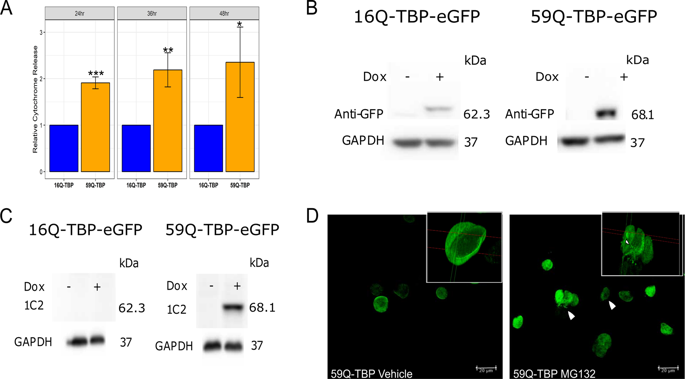当前位置:
X-MOL 学术
›
Cell Death Dis.
›
论文详情
Our official English website, www.x-mol.net, welcomes your feedback! (Note: you will need to create a separate account there.)
Interferon mediated neuroinflammation in polyglutamine disease is not caused by RNA toxicity.
Cell Death & Disease ( IF 9 ) Pub Date : 2020-01-02 , DOI: 10.1038/s41419-019-2193-x Aksheev Bhambri 1, 2 , Akeeth Pinto 2 , Beena Pillai 1, 2
Cell Death & Disease ( IF 9 ) Pub Date : 2020-01-02 , DOI: 10.1038/s41419-019-2193-x Aksheev Bhambri 1, 2 , Akeeth Pinto 2 , Beena Pillai 1, 2
Affiliation

|
Polyglutamine diseases are neurodegenerative diseases that occur due to the expansion of CAG repeat regions in coding sequences of genes. Previously, we have shown the formation of large protein aggregates along with activation of the interferon pathway leading to apoptosis in a cellular model of SCA17. Here, we corroborate our previous results in a tetracycline-inducible model of SCA17. Interferon gamma and lambda were upregulated in 59Q-TBP expressing cells as compared to 16Q-TBP expressing cells. Besides interferon-stimulated genes, the SCA17 model and Huntington's mice brain samples showed upregulation of RNA sensors. However, in this improved model interferon pathway activation and apoptosis preceded the formation of large polyglutamine aggregates, suggesting a role for CAG repeat RNA or soluble protein aggregates. A polyglutamine minus mutant of TBP, expressing polyCAG mRNA, was created by site directed mutagenesis of 10 potential start codons. Neither this long CAG embedded mRNA nor short polyCAG RNA could induce interferon pathway genes or cause apoptosis. polyQ-TBP induced the expression of canonical RNA sensors but the downstream transcription factor, IRF3, showed a muted response. We found that expanded CAG repeat RNA is not sufficient to account for the neuronal apoptosis. Neuronal cells sense expanded CAG repeats embedded in messenger RNAs of protein-coding genes. However, polyglutamine containing protein is responsible for the interferon-mediated neuroinflammation and cell death seen in polyglutamine disease. Thus, we delineate the inflammatory role of CAG repeats in the mRNA from the resulting polyglutamine tract in the protein. Embedded in messenger RNAs of protein-coding regions, the cell senses CAG repeat expansion and induces the expression of RNA sensors and interferon-stimulated genes.
中文翻译:

聚谷氨酰胺疾病中干扰素介导的神经炎症不是由RNA毒性引起的。
聚谷氨酰胺疾病是神经退行性疾病,由于基因编码序列中CAG重复区域的扩展而发生。以前,我们已经显示出大蛋白聚集体的形成以及干扰素途径的激活,导致SCA17细胞模型中的细胞凋亡。在这里,我们证实了在四环素诱导的SCA17模型中的先前结果。与表达16Q-TBP的细胞相比,干扰素γ和λ在表达59Q-TBP的细胞中被上调。除了干扰素刺激的基因外,SCA17模型和亨廷顿氏病小鼠的大脑样本还显示出RNA传感器的上调。但是,在这种改进的模型中,干扰素途径的激活和凋亡先于大的聚谷氨酰胺聚集体的形成,提示了CAG重复RNA或可溶性蛋白质聚集体的作用。通过定点诱变10个潜在起始密码子,创建了表达polyCAG mRNA的TBP聚谷氨酰胺负突变体。这种长的CAG嵌入的mRNA和短的polyCAG RNA都不能诱导干扰素途径基因或引起细胞凋亡。polyQ-TBP诱导了规范RNA传感器的表达,但下游转录因子IRF3却显示出沉默的反应。我们发现扩展的CAG重复RNA不足以解决神经元凋亡。神经元细胞感觉到嵌入在蛋白质编码基因信使RNA中的扩大的CAG重复序列。然而,在聚谷氨酰胺疾病中发现,含有聚谷氨酰胺的蛋白质是干扰素介导的神经炎症和细胞死亡的原因。因此,我们从蛋白质中产生的聚谷氨酰胺束中划出了在mRNA中CAG重复序列的炎症作用。
更新日期:2020-01-09
中文翻译:

聚谷氨酰胺疾病中干扰素介导的神经炎症不是由RNA毒性引起的。
聚谷氨酰胺疾病是神经退行性疾病,由于基因编码序列中CAG重复区域的扩展而发生。以前,我们已经显示出大蛋白聚集体的形成以及干扰素途径的激活,导致SCA17细胞模型中的细胞凋亡。在这里,我们证实了在四环素诱导的SCA17模型中的先前结果。与表达16Q-TBP的细胞相比,干扰素γ和λ在表达59Q-TBP的细胞中被上调。除了干扰素刺激的基因外,SCA17模型和亨廷顿氏病小鼠的大脑样本还显示出RNA传感器的上调。但是,在这种改进的模型中,干扰素途径的激活和凋亡先于大的聚谷氨酰胺聚集体的形成,提示了CAG重复RNA或可溶性蛋白质聚集体的作用。通过定点诱变10个潜在起始密码子,创建了表达polyCAG mRNA的TBP聚谷氨酰胺负突变体。这种长的CAG嵌入的mRNA和短的polyCAG RNA都不能诱导干扰素途径基因或引起细胞凋亡。polyQ-TBP诱导了规范RNA传感器的表达,但下游转录因子IRF3却显示出沉默的反应。我们发现扩展的CAG重复RNA不足以解决神经元凋亡。神经元细胞感觉到嵌入在蛋白质编码基因信使RNA中的扩大的CAG重复序列。然而,在聚谷氨酰胺疾病中发现,含有聚谷氨酰胺的蛋白质是干扰素介导的神经炎症和细胞死亡的原因。因此,我们从蛋白质中产生的聚谷氨酰胺束中划出了在mRNA中CAG重复序列的炎症作用。


























 京公网安备 11010802027423号
京公网安备 11010802027423号